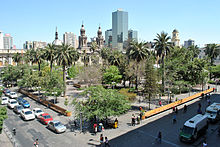Plaza de Armas (Santiago): Difference between revisions
Yngvadottir (talk | contribs) m Grammar correction, Spanish. This edit is not an endorsement of the WMF. |
|||
| Line 17: | Line 17: | ||
|archivedate = 5 November 2013 |
|archivedate = 5 November 2013 |
||
}}</ref> |
}}</ref> |
||
===Pre Hispanic Period (Pre Colonisation) === |
|||
The Investigator[[Rubén Stehberg]] from the [[Museo Nacional de Historia Natural de Chile]] and Gonzalo Sotomayor of the [[Universidad Andrés Bello]] provided evidence in 1976,<ref>[http://www.lagranepoca.com/26884-descubren-ciudad-inca-mapocho-oculta-bajo-santiago-chile?fb_action_ids=4953758757924&fb_action_types=og.likes&fb_source=other_multiline&action_object_map=%7B%224953758757924%22%3A146224505535423%7D&action_type_map=%7B%224953758757924%22%3A%22og.likes%22%7D&action_ref_map Descubren ciudad inca de Mapocho oculta bajo Santiago de Chile]</ref> arguing that under the old city of Santiago where the Plaza de Armas is situated there is an old Inca settlement.<ref>[http://www.mnhn.cl/Vistas_Publicas/publicNoticias/noticiasPublicDetalle.aspx?idNoticia=42691 Santiago:Una ciudad fundada sobre otra ciudad] {{Wayback|url=http://www.mnhn.cl/Vistas_Publicas/publicNoticias/noticiasPublicDetalle.aspx?idNoticia=42691|date=20141023151004}}</ref><ref>[http://www.dibam.cl/Recursos/Noticias/Museo%20Nacional%20de%20Historia%20Natural/archivos/Art%C3%ADculo%20Mapocho%20Incaico%20MNHN.pdf Artículo "Mapocho Incaico" (3000 kb )]</ref> |
|||
{{Cita|There would have been a Tawantinsuyu (Inca Empire) urban centre, under the old city of Santiago, from which Inca roads went out in different directions and whose base of sustenance was hydro-agriculture and gold and silver mining, [...] the infrastructure of this installation would have been used by (the Spanish conqueror) Pedro de Valdivia to found the city of Santiago.|Rubén Stehberg<ref name="Steh1">{{enlace roto|1=[http://vimeo.com/69550290 Entrevista al arqueólogo Rubén Stehberg acerca de la ciudadela inca del Mapocho] |2=http://vimeo.com/69550290 |bot=InternetArchiveBot }}</ref><ref name="Steh2">[http://www.plataformaurbana.cl/seleccion/descubren-ciudad-inca-de-mapocho-oculta-bajo-santiago-de-chile/ Descubren ciudad inca de Mapocho oculta bajo Santiago de Chile] {{Wayback|url=http://www.plataformaurbana.cl/seleccion/descubren-ciudad-inca-de-mapocho-oculta-bajo-santiago-de-chile/ |date=20150924093458 }}</ref><ref>{{Cita web |url=http://www.dibam.cl/Recursos/Noticias/Museo%20Nacional%20de%20Historia%20Natural/archivos/Art%C3%ADculo%20Mapocho%20Incaico%20MNHN.pdf |título=Mapocho Incaico |fechaacceso=26 de diciembre de 2013 |apellido=Stehberg |nombre=Rubén}}</ref>}} |
|||
== Freedom of Latin America monument == |
== Freedom of Latin America monument == |
||
Revision as of 16:12, 18 February 2024
This article relies largely or entirely on a single source. (June 2012) |

The Plaza de Armas is the main square of Santiago, the capital of Chile. Plaza de Armas metro station is located under the square. Surrounding the square are some historic buildings, including the Metropolitan Cathedral of Santiago, Central Post Office Building, Palacio de la Real Audiencia de Santiago, and the building that serves as the seat of local government for Santiago, which was formerly occupied by the Cabildo of the city before being remodeled.[1] There are also other architecturally significant buildings that face the square, including the Capilla del Sagrario, the Palacio arzobispal, the Edificio Comercial Edwards, and the Portal Fernández Concha. The Casa Colorada, the Cuartel General del Cuerpo de Bomberos de Santiago and the Museo Chileno de Arte Precolombino are located a short walk from the square.
The square, the nearby former National Congress building and surrounding buildings were registered on 3 December 1986 as a national monument as a zona típica.[1]
History
The church is the centerpiece of the initial layout of Santiago, which has a square grid pattern. This urban design was accomplished by Pedro de Gamboa, who was appointed by Pedro de Valdivia in 1541.[1]
Pre Hispanic Period (Pre Colonisation)
The InvestigatorRubén Stehberg from the Museo Nacional de Historia Natural de Chile and Gonzalo Sotomayor of the Universidad Andrés Bello provided evidence in 1976,[2] arguing that under the old city of Santiago where the Plaza de Armas is situated there is an old Inca settlement.[3][4]
There would have been a Tawantinsuyu (Inca Empire) urban centre, under the old city of Santiago, from which Inca roads went out in different directions and whose base of sustenance was hydro-agriculture and gold and silver mining, [...] the infrastructure of this installation would have been used by (the Spanish conqueror) Pedro de Valdivia to found the city of Santiago.
Freedom of Latin America monument
The monument is located at the center of the square and depicts an allegory of Freedom, with a woman breaking the chains of a native woman. It is made of Carrara marble and sculpted by Francesco Orselino.[8] The monument replaced a bronze fountain made in 1671, which is presently located in La Moneda Palace.[9]
Other commemorative structures include an equestrian statue of Pedro de Valdivia, a statue of James the Great, the indigenous peoples monument, a time capsule, and ground plaques, including that marking the kilometre zero of Santiago.
See also
References
- ^ a b c "Plaza de Armas, Congreso Nacional y su entorno" (in Spanish). National Monuments Council. Archived from the original on 5 November 2013. Retrieved 22 May 2012.
- ^ Descubren ciudad inca de Mapocho oculta bajo Santiago de Chile
- ^ Santiago:Una ciudad fundada sobre otra ciudad Template:Wayback
- ^ Artículo "Mapocho Incaico" (3000 kb )
- ^ Entrevista al arqueólogo Rubén Stehberg acerca de la ciudadela inca del Mapocho[dead link]
- ^ Descubren ciudad inca de Mapocho oculta bajo Santiago de Chile Template:Wayback
- ^ Stehberg, Rubén. "Mapocho Incaico" (PDF). Retrieved 26 December 2013.
- ^ Lahr Brandolini, Renata (5 March 2011). "Refrescante patrimonio urbano". El Mercurio. Retrieved 19 February 2021.
- ^ Rodríguez, Hernán (1983). Palacio de la Moneda (in Spanish). Santiago: Dibam. p. 81.
